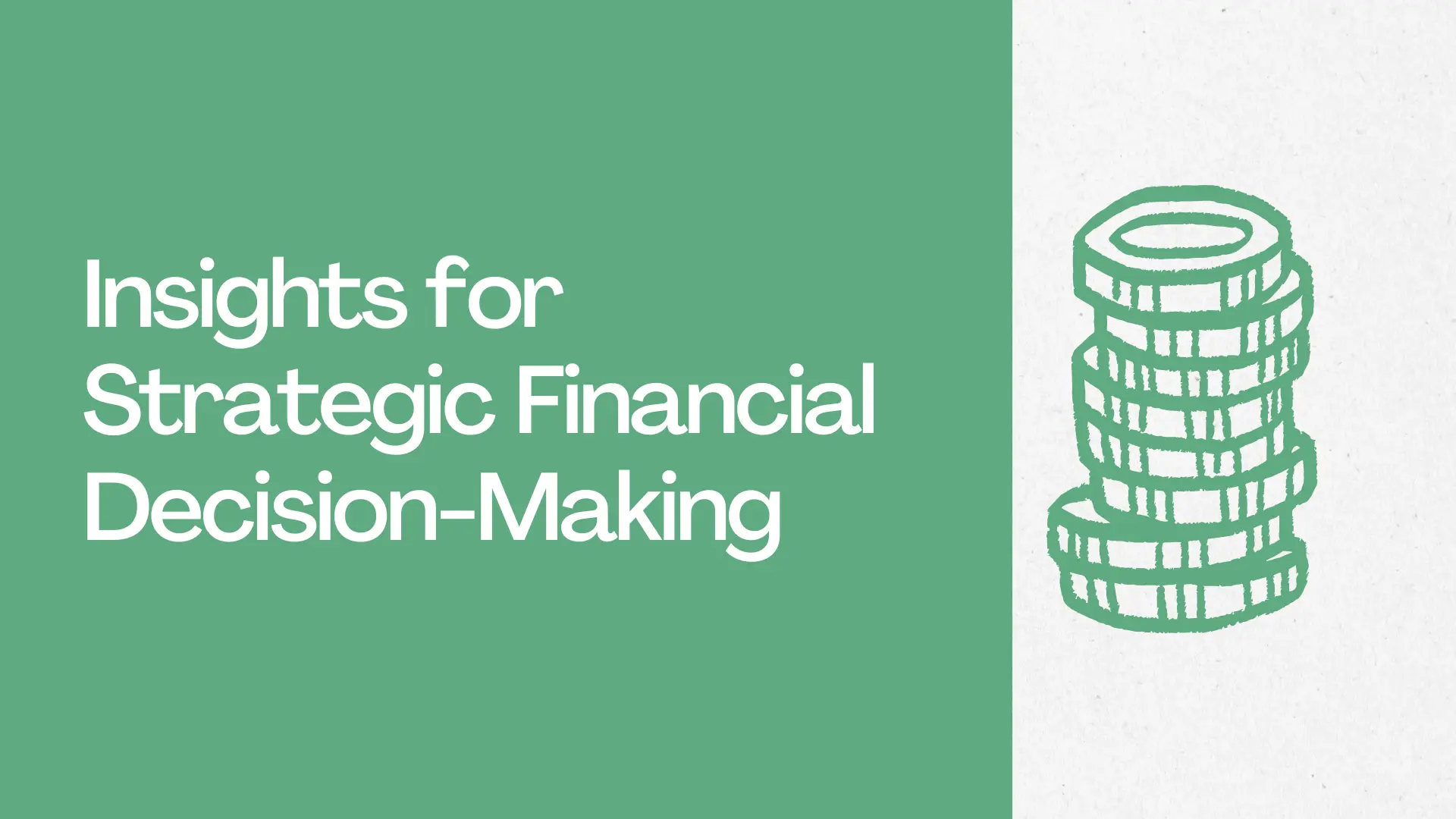
Insights for Strategic Financial Decision-Making, In today’s dynamic business environment, making informed financial decisions is crucial for the success and sustainability of any organization. Whether you’re a small startup or a multinational corporation, understanding the intricacies of strategic financial decision-making can significantly impact your bottom line and long-term growth. This article delves into essential insights to help guide your financial strategies effectively.
Introduction to Strategic Financial Decision-Making
Strategic financial decision-making involves analyzing data, assessing risks, and allocating resources to achieve organizational goals. It requires a comprehensive understanding of financial metrics, market trends, and internal capabilities. By aligning financial decisions with strategic objectives, businesses can optimize performance and capitalize on growth opportunities.
Importance of Data Analysis in Financial Decision-Making
Data analysis forms the foundation of sound financial decision-making. By leveraging financial data, businesses can gain valuable insights into their performance, identify trends, and forecast future outcomes. Advanced analytics tools enable organizations to extract actionable intelligence, empowering decision-makers to make informed choices and mitigate risks effectively.
Understanding Key Financial Metrics
To make informed decisions, it’s essential to understand key financial metrics such as revenue, expenses, and profit margins. Revenue reflects the total income generated by the business, while expenses encompass all costs incurred in operations. Profit margins indicate the efficiency and profitability of the business, guiding strategic initiatives to enhance financial performance.
Risk Assessment and Management
Effective risk assessment and management are integral to strategic financial decision-making. By identifying potential risks and implementing proactive measures, organizations can safeguard their financial stability and mitigate potential losses. Risk management strategies should be adaptive and responsive to evolving market conditions and regulatory requirements.
Long-term vs. Short-term Financial Planning
Balancing long-term strategic objectives with short-term financial goals is essential for sustainable growth. While short-term planning focuses on immediate operational needs and cash flow management, long-term planning involves setting strategic priorities, investing in innovation, and building resilience against market disruptions.
Leveraging Technology for Financial Insights
Advancements in technology have revolutionized financial decision-making processes. From sophisticated analytics platforms to artificial intelligence and machine learning algorithms, businesses have access to powerful tools that can analyze vast amounts of data and uncover actionable insights. By harnessing technology, organizations can gain a competitive edge and drive strategic growth initiatives.
Strategic Allocation of Resources
Optimizing resource allocation is critical for maximizing returns and minimizing waste. Strategic financial decision-makers must prioritize investments that align with organizational objectives and deliver sustainable value. Whether it’s allocating capital for expansion projects, research and development, or talent acquisition, resource allocation should be guided by rigorous analysis and risk assessment.
Financial Decision-Making in Times of Uncertainty
Navigating uncertainty requires agility and resilience in financial decision-making. Economic fluctuations, geopolitical tensions, and sextap unexpected events can disrupt business operations and impact financial performance. By adopting a proactive approach, businesses can anticipate potential challenges, diversify risk, and capitalize on emerging opportunities amidst uncertainty.
Incorporating Environmental, Social, and Governance (ESG) Factors
In today’s socially conscious landscape, incorporating environmental, social, and governance (ESG) factors into financial decision-making is paramount. Investors, consumers, and regulators are increasingly scrutinizing businesses’ sustainability practices and ethical standards. By integrating ESG considerations into decision-making processes, organizations can enhance their reputation, attract investors, and mitigate risks associated with environmental and social issues.
Importance of Stakeholder Communication
Effective communication with stakeholders is essential for gaining support and buy-in for financial decisions. Whether it’s shareholders, employees, customers, or regulatory bodies, transparent and timely communication fosters trust and alignment of interests. By keeping stakeholders informed about financial performance, strategic initiatives, and risk management efforts, organizations can build lasting relationships and mitigate potential conflicts.
Case Studies: Successful Financial Decision-Making
Examining real-world case studies provides valuable insights into successful financial decision-making strategies. By analyzing the approaches taken by industry leaders and innovative startups, businesses can learn from best practices, identify pitfalls to avoid, and adapt proven strategies to their unique circumstances.
The Role of Leadership in Financial Strategy
Effective leadership is instrumental in driving financial strategy and fostering a culture of accountability and innovation. Leaders must demonstrate vision, integrity, and decisiveness in navigating complex financial landscapes. By empowering teams, fostering collaboration, and leading by example, leaders can inspire confidence and guide organizations towards sustainable growth and success.
Continuous Learning and Adaptation
The financial landscape is constantly evolving, requiring continuous learning and adaptation. Financial decision-makers must stay abreast of emerging trends, regulatory changes, and technological advancements to remain competitive. By fostering a culture of learning and embracing innovation, organizations can adapt to changing market dynamics and seize new opportunities for growth.
Conclusion, Financial Decision-Making
Strategic financial decision-making is a multifaceted process that requires a deep understanding of financial principles, market dynamics, and organizational objectives. By leveraging data-driven insights, managing risks effectively, and fostering stakeholder engagement, businesses can navigate uncertainty and achieve sustainable growth in today’s dynamic business environment.
FAQs
- What role does technology play in strategic financial decision-making?Technology plays a pivotal role in strategic financial decision-making by providing advanced analytics tools, automation capabilities, and real-time insights into financial performance.
- How can businesses balance short-term financial goals with long-term strategic objectives?Businesses can balance short-term and long-term goals by prioritizing investments that align with strategic priorities, optimizing resource allocation, and fostering a culture of innovation and agility.
- Why is stakeholder communication important in financial decision-making?Stakeholder communication fosters transparency, trust, and alignment of interests, enabling businesses to gain support for financial decisions and mitigate potential conflicts.
- What are some key considerations for incorporating ESG factors into financial decision-making?Key considerations include assessing environmental and social risks, aligning business practices with sustainable principles, and communicating ESG initiatives to stakeholders effectively.
- How can organizations foster a culture of continuous learning and adaptation in financial decision-making?Organizations can foster a culture of continuous learning by investing in employee development, embracing innovation, and encouraging experimentation and knowledge sharing.
Leave a Reply